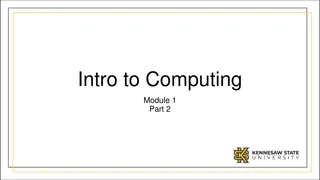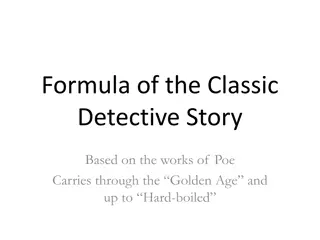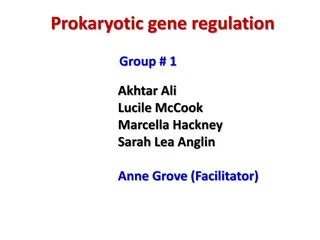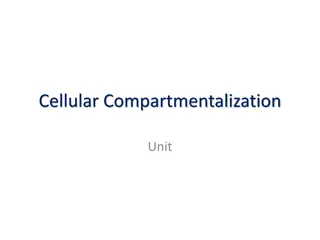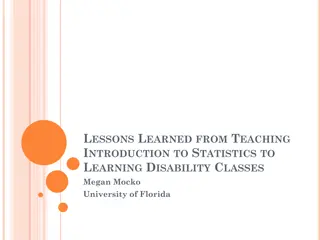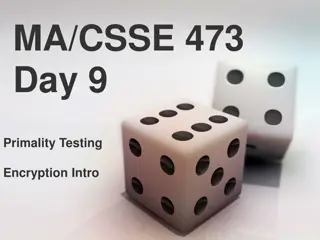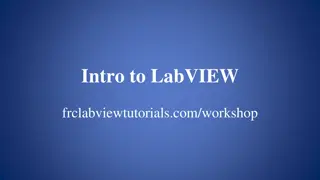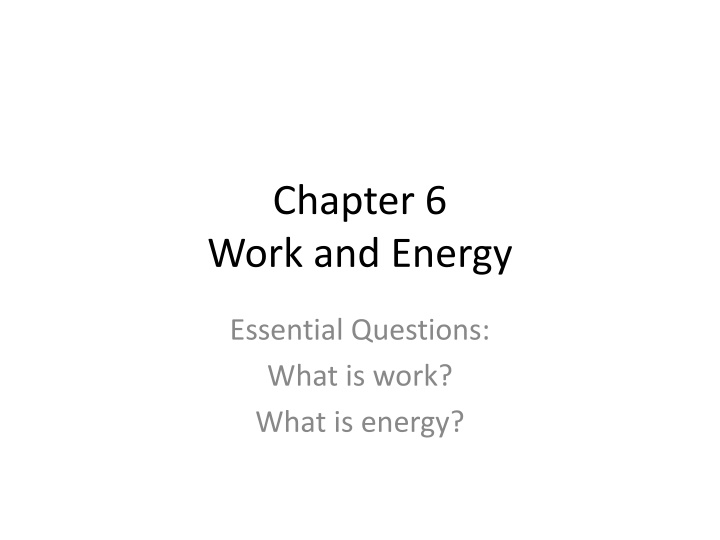
Work and Energy in Physics
Explore the concepts of work and energy in physics, including definitions, examples, and practical lab activities. Learn how to compute work using force and displacement, and delve into real-world scenarios like inclined plane experiments and roller coaster design considerations.
Download Presentation

Please find below an Image/Link to download the presentation.
The content on the website is provided AS IS for your information and personal use only. It may not be sold, licensed, or shared on other websites without obtaining consent from the author. If you encounter any issues during the download, it is possible that the publisher has removed the file from their server.
You are allowed to download the files provided on this website for personal or commercial use, subject to the condition that they are used lawfully. All files are the property of their respective owners.
The content on the website is provided AS IS for your information and personal use only. It may not be sold, licensed, or shared on other websites without obtaining consent from the author.
E N D
Presentation Transcript
Chapter 6 Work and Energy Essential Questions: What is work? What is energy?
Where must we start? For something to happen (pendulum to swing, coaster to roll, etc.), we must start with .
Work When a force acts upon an object to cause a displacement of the object, it is said that work was done upon the object. There are three key ingredients to work - force, displacement, and cause. In order for a force to qualify as having done work on an object, there must be a displacement and the force must cause the displacement. PCR http://www.physicsclassroom.com/Class/energy/ u5l1a.cfm
Work W = Force dot displacement W = F r cos Units: joule (J) one J = 1.0N x 1.0m Work is a scalar quantity Work is defined as: 1. The use of energy to accomplish something. 2. The process where a force acts through a displacement to transfer energy from one object (or one form) to another. OR W=(F)( r)cos
Lab: How do you compute Work? The amount of work can be determined by what the worker (you in this case) gets done. You will get done the same thing in each trial. However, you will do it with varying forces each trial, over varying displacements. Your goal is to practice mathematically combining force and displacement to compute work. Also, understand the units for work.
Inclined Plane Activity 1. 2. Tilt the ramp against a support. Measure the 2-D displacement needed (length of ramp) to raise the lab cart exactly 1.00m vertically. Measure the force needed to drag the cart up the incline at a constant speed. Be sure to pull scale parallel to the track! Repeat at other angles for the track, until you have done one more trial than # of students in the group. Determine the product of the force and displacement for each of the trials. Do the first trial as a group, then each student takes responsibility for one of the remaining trials. Report: Objective, sketch set-up, label, record measurements and results neatly in a table, show calculations 3. 4. 5. 6.
Example Problem: Before beginning its initial descent, a roller coaster car is always pulled up the first hill to a high initial height. Work is done on the car (usually by a chain) to achieve this initial height. A coaster designer is considering three different incline angles at which to drag the 2000-kg car train to the top of the 60-meter high hill. In each case, the force applied to the car will be applied parallel to the hill. Her critical question is: which angle would require the most work? Analyze the data, determine the work done in each case, and answer this critical question.
Example Problem: Angle 35 45 55 Force (N) 1.12x104 1.39x104 1.61x104 Disp. (m) Work (J) 105 84.9 73.2
What is needed to do work? ENERGY
Energy is The ability to do WORK
Mechanical Energy is either: Kinetic or Potential
Wnet= K Wnet= K ( F) ( x) cos = Kf Ko If the net force is in the direction of the displacement, and the initial speed is zero ( F) ( x) cos 0 = Kf 0 (m)(a) ( x) = Kf (m) (vf2 vo2)/2 = Kf 1/2mvf2= Kf K = 1/2mv2
Kinetic Energy K = mv2
Gravitational Potential Energy Ug= mgh (or mgy) Us= k( l)2
Power is the rate at which
Power is the rate at which work is done or the rate at which energy is transferred P= W/ t or P = E/ t
Power is But, Since: P=W/ t P= (F . x)/ t Then P= F .vavg









